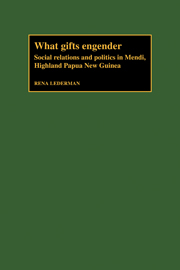Book contents
- Frontmatter
- Contents
- List of tables, figures, and maps
- Preface
- Acknowledgments
- 1 Mendi coming into view
- 2 Sem relations: solidarity and its limits
- 3 Twem: personal exchange partnerships
- 4 Gender ideology and the politics of exchange
- 5 Twem and sem in context
- 6 Sai le at Senkere: the politics of a Pig Festival
- 7 “Development” in Mendi
- Appendix A The research community
- Appendix B The “accounts sample” and some comments on research methodology
- Notes
- Glossary
- References
- Index
1 - Mendi coming into view
Published online by Cambridge University Press: 04 August 2010
- Frontmatter
- Contents
- List of tables, figures, and maps
- Preface
- Acknowledgments
- 1 Mendi coming into view
- 2 Sem relations: solidarity and its limits
- 3 Twem: personal exchange partnerships
- 4 Gender ideology and the politics of exchange
- 5 Twem and sem in context
- 6 Sai le at Senkere: the politics of a Pig Festival
- 7 “Development” in Mendi
- Appendix A The research community
- Appendix B The “accounts sample” and some comments on research methodology
- Notes
- Glossary
- References
- Index
Summary
… quite suddenly, at a spot where a large tree had recently fallen, we came to a break in the forest. And as we looked excitedly northwards, O'Malley and myself stood spellbound gazing at the scene of wild and lonely splendor.
Below us, on the opposite side of the Ryan [River], a large lake lay on a platform of the divide, while about two miles to the northwards; and beyond the gorge, gold and green, reaching as far as the eye could see, lay the rolling timbered slopes and grasslands of a huge valley system. On every slope were cultivated squares while little columns of smoke rising in the still air revealed to us the homes of the people of this land. … Beyond all stood the heights of some mighty mountain chain that sparkled in places with the colors of the setting sun. As I looked on those green cultivated squares of such mathematical exactness, I thought of wheatfields, or the industrious areas of a colony of Chinese. …
“My mother!,” said Sergeant Orai. “People like the sand. They have plantations. What people are they?”
[Hides 1936: 77–8]Introduction
In April 1935, after more than three months of marching across sparsely populated country, and after scaling the massive limestone barrier of the Karius Range, an exhausted troop of Australian government officers and coastal Papuan policemen and carriers marveled at their first sight of the land of the Huli, in the Papuan Highlands. The Hides and O'Malley patrol never entered the valley of the Mendi River, whose people – Ip Mend Ol – are the subjects of this study.
- Type
- Chapter
- Information
- What Gifts EngenderSocial Relations and Politics in Mendi, Highland Papua New Guinea, pp. 1 - 18Publisher: Cambridge University PressPrint publication year: 1986



